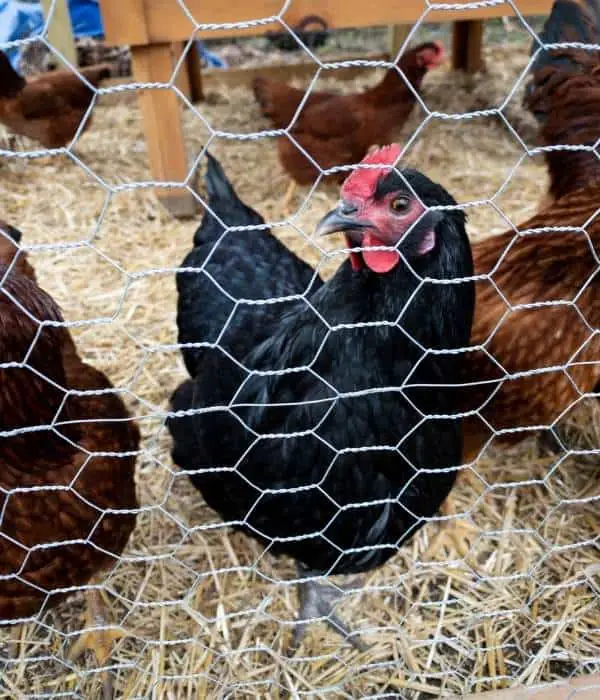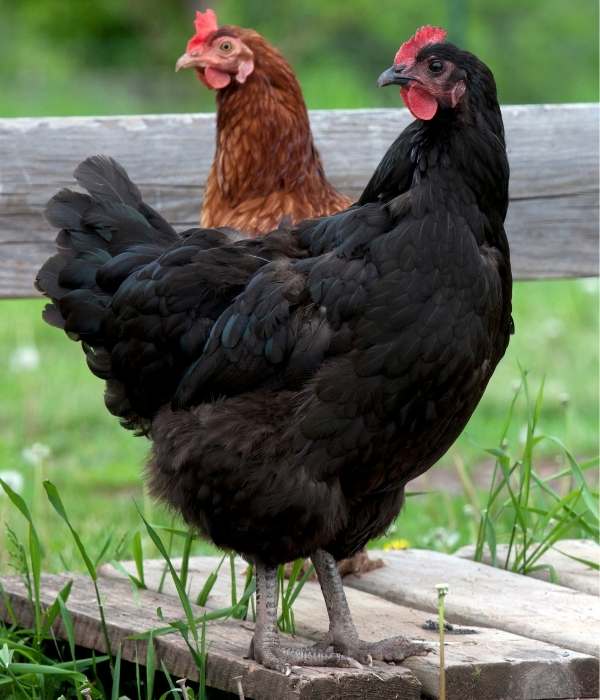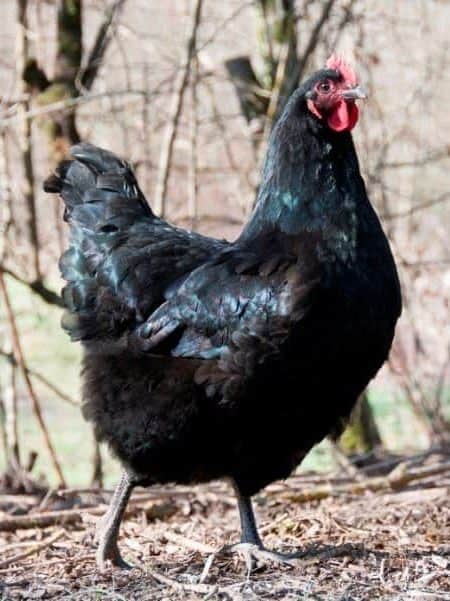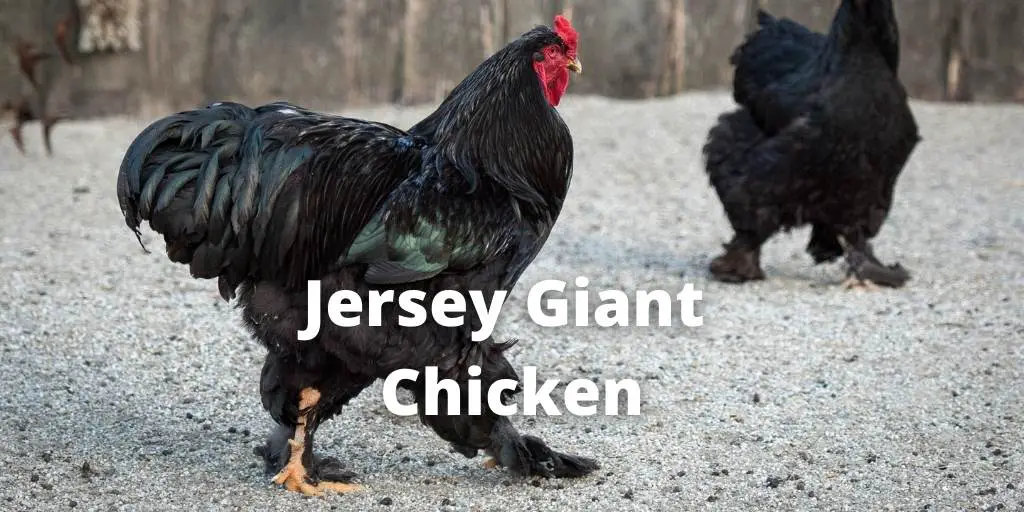Are you interested in raising this Jersey Giant chicken? If yes, this breed guide will help you to know all about Jersey Black Giant.
Jersey Giant is an excellent choice for those who want to raise some jumbo egg layers and meat chickens.
You will get complete and brief information about the facts, history, size, color, appearance, and benefits of raising Jersey Giant chickens in this article.
Before you make a decision, read Jersey Giant is right for your backyard or not.
What is Jersey Giant Chicken?

Jersey Giant chicken, as the name suggests, it’s a giant chicken that is widely bred for egg purposes. This variety of chicken is developed by mixing Black Java, Black Tangshan, and Dark Brahmas, and it was named Jersey Giants in 1917.
It’s a variety of sex-linked chicken, and it’s a hybrid chicken breed. These breeds are well-known for their size.
Jersey Giant chickens are larger than any other chicken variety but are very friendly, gentle, and calm personalities. That’s why most of the poultry farmers like to raise them.
Those chicken owners searching for a good-natured breed might consider adding this Jersey giant chicken to their flocks.
Common Names of Jersey Giant Chicken
Below are a few common names of Jersey Giant Chicken:
- Jersey Black Giant.
- Giant
- Black Giant
History of Jersey Giant Chicken
The Jersey Giant Chicken is the largest chicken breed in the United States and is initially developed by two persons, namely Thomas Black and John, near Jobstown, New Jersey.
This breed is considered one of the world’s huge chicken breeds that lay giant eggs.
The large body of Jersey Giants made it popular as a meat chicken, and many chicken owners thought they could make a huge demand for these large roosting birds.
There was a significant demand around the 1870s and 1890s, and they surpassed the standard turkey at that time.
Jersey Giant chicken takes 8 to 9 months to reach its full size, usually an extended period if we compare it with other chicken breeds.
The availability of turkey in the market increased in less price, as a result of which the demand of this Jersey Giant chickens as a roosting fowl fell.
Lifespan
The Jersey Giant chicken lifespan is about 6-7 years.
Jersey Giant Chicken Breed Standard

White Jersey Giant chickens have white color feathers and cream or willow-colored legs. The Blue Jersey giants have darker and black shanks, and they are grayish blue.
Original breed standards indicate that all Jersey Giant chickens have yellow skin, and they have red combs and wattles with brown eyes. Their beaks are usually pale yellow or black, which mainly depends on their feather coloring.
Jersey Giants have a muscular body, and the feathers are close to their body, which makes them look clean and elegant. Legs have no feathers, and the tails of Jersey Giant chicken are relatively short.
Egg Production
The Jersey Giant hens go broody very less, but they aren’t great sitters because of their weight. Sadly, they are prone to break the eggs. That’s why, if possible, use an incubator to hatch their eggs to get cute chicks.
The Jersey Giant chickens are excellent egg layers. The eggs of this chicken are brown. They are remarkably bigger than the average chicken egg.
Because they’re so big, the chicks take a couple of extra days to hatch. The weight of Jersey Giant hen eggs is around 55-60 gm.
Studies show that the Jersey Giant chickens lay more eggs than any other large breed. Also, this breed is considered a pretty good egg layer.
On average, they produce 2-4 eggs each week, and in total, you will get 150 to 200 eggs in a year.
They are good mothers, and they enjoy taking care of their chicks. But because of their heavyweight, they are not able to brood their chicks easily.
Temperament of Jersey Giant Chicken
This Jersey Giant is a docile and mellow bird. Even the roosters are very friendly birds. They make good pets for the backyard or barn.
The large size of the Jersey Giants makes them intimidating to the smaller children, as they stand so tall. Because of their gentle nature, they are a good choice for the bird that will be near children or pets.
They work well to establish flocks because they get along well with other chickens and don’t peck often.
Jersey Giants are not aggressive and do not use their size to intimidate other animals, which makes them seem imposing.
Many chickens prefer to stay away from the Great Giant, and hawks don’t usually attack them because they’re too big for a hawk to carry away.
But hawks may attack their chicks so use a good chicken coop camera and fencing for your chicken coop.
Color, Size, Appearance, Characteristics of Jersey Giant Chicken

Color and Appearance
There are 3 different colors of Jersey Giant registered in the American Poultry Association. The three types of legs are a little different in color.
Black Jersey Giant- The black variety is the first color of this breed and is widely recognized in 1922. They have four toes, clean legs, and black shanks.
White Jersey Giant- Pure breeding white birds are formed by breeding between black flock and those having a white spot and are registered in 1947. They have clean legs, four toes, dark willow shanks.
Blue Jersey Giant- Blue breed varieties were formed by breeding plumage color and were registered in 2003. They have willow color shanks with clean legs and four toes.
Black Jersey Giant chickens are black, and they have black feathers and legs. Their feathers also have an iridescent purple or green sheen to them in the sunlight.
They are called statuesque and are about 2 feet tall. They have a large body and grow slowly, taking about a year for their body to fill out. Their backs have a slight curve and their body forms a U-shape.
Size
Before, this breed standard was a large frame with yellow skin and a single comb, but now their size is smaller than their ancestors, but they are still big birds.
The U.S. Department of Agriculture says that male Jersey Giants weigh between 13 and 15 lbs and are between 22 and 26 inches tall, while females weigh between 11 lbs and are between 16 and 20 inches tall.
Characteristics
The Jersey Giant Chicken is very friendly and is perfect for families having pets and children. Please read our guide to know more about pet chickens.
Benefits of Raising Jersey Giant chickens
These birds are healthy and don’t get many illnesses, but it’s important to vaccinate them.
It is one of the best and largest dual-purpose chicken for backyard chicken lovers. You will get both eggs and meat from this chicken.
The large size of Jersey Giant chicken is also unique, which gives a reason to raise this bird. They are very calm and friendly, so they will be very friendly with the flocks already present.
Problems in Raising Jersey Giant chickens
One of the significant potential health issues is leg injury. Usually, these injuries occur when the Jersey Giants fly or jump from a high space.
Because of their bulky body, landings can often lead to injuries. So, it is advisable to place the perches closer to the ground to reduce the risk of such injuries.
They require a good amount of space to roam, and these Jersey Giant chickens prefer to have a staple diet, similar to other chickens.
As they take a long time to grow fully, they require more food, but you can make money by selling eggs and birds when they become adults.
They are good foragers because their heavyweight predators like foxes, wild dogs, and raccoons easily harm them. So, build good fencing for them.
Please read our guide on the best chicken wire and hardware cloth for fencing.
Some Tips for Raising Jersey Giant Chickens
Jersey Giant chickens are robust and relatively cold hardy. They are excellent in cold weather climates and may not fare as well in hot weather climates.
Chickens should get an adequate supply of vitamins and minerals to help them reach their full potential. It also helps the chicken grow stronger bones, which reduces the risk of leg injuries.
Adding vitamins and minerals to a chicken’s food is an excellent way to provide a proper diet and allows the Jersey Giant chicken to roam free and forage.
Jersey Giant chickens perches are placed low to the ground, so you should keep that in mind when creating a space for them. It makes the Jersey Giant chicken easily reach the perches without getting hurt.
Also, Jersey Giant chickens are large, so you need more space than the other small to medium-sized chicken breeds. You need around 6-8 sq. feet of space for each bird in the coop and 25-30 sq. feet for each bird in the run area.
Conclusion
For several years, this Jersey Giant chicken serves as an excellent addition to other flocks. Many people raise the bird for meat, but now it is a dual-purpose chicken.
They are very gentle and have a friendly personality. The calm temperament of this Jersey Giant chicken is the primary reason behind its popularity.
Are you raising Jersey Giant chickens in your backyard? Share your experience in the comment section.

We have a NJ giant. She’s big black & beautiful. She does better in colder weather. Her feathers fall out when it’s hot & she gets picked on by the rooster. The other hens pick on her & pull her feathers out. We’ve separated her, until her feathers grow back in. She’s my favorite chicken so it pains me to see her treated so poorly by the others. Her feathers look really hard & painful. Is this normal for giants to lose their all their feathers? I’ve upped protein w/ feather fixer & mealy worms.
Hi Nicole,
Not all the chickens of this breed lose their feathers. You can see this type of molting in some specific type of strains.
Better to keep the non molted one separate from other chickens until the feather grows.
Best way to get rid of chicken mits